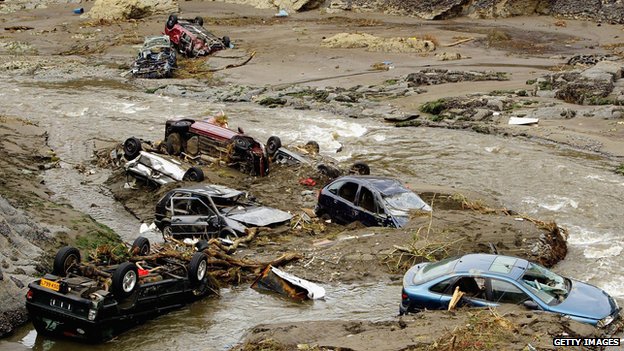Also discussed here: Climate change to boost summer flash floods, says study (Matt McGrath, BBC news, Jun. 1, 2014)
Today we review an article that describes nine months of simulations with the British supercomputer normally used for numerical weather prediction but using a much finer 1.5 km resolution, instead of the normal 12 km grid and using the IPCC scenario for rapid climate warming. The results indicate, not unexpectedly, that the added moisture in warmer air masses during summer would produce more intense rainfall rates than at present and as much as five times more heavy rainfalls – even though the summer total rainfall, as a whole, would likely be drier. The apparently contradictory conclusion reveals what many people who do not look at rainfall statistics might find surprising- that very heavy rainfall (say over 10-20 mm/day) only occurs once or twice a month at places not subject to ocean storms or storms enhanced by mountains (such as Argentina/Colombia for example).
The accumulated monthly total depends not only on the heavy rain days but also on the number of many light rain or drizzle days. In this case, it appears that there might be an increase in the number of heavy rain days and a decrease in the lighter ones – which is the scenario expected when you shift from many overcast “drizzly” days to a few thunderstorm days. This fits well with the scenarios that scientists in Europe, the US and Canada have been predicting in general terms for decades from computerized climate models with coarser resolution– more convective storms because of hotter surface temperatures and heavier amounts because of the added moisture in the air. This computer experiment now confirms these estimates with more precision and suggests that flood authorities in other countries take note, not just those in the UK.

Key Quotes:
“researchers say there could be five times the number of "extreme rainfall events" per hour, under extreme warming projections.”
“Until now, their climate models have not been good enough to work out the effect on extreme hourly rainfall in the warmer months. To improve the resolution of their model, researchers in this latest experiment used 1.5km grid spacings instead of the normal 12km. “
"It is dry periods interspersed with these very intense downpours, and we are talking about thresholds of 30mm and above in an hour over quite a large area here, which would be associated with really severe flash flooding,"
“the 1.5 km model also shows a future intensification of short-duration rain in summer, with significantly more events exceeding the high thresholds indicative of serious flash flooding.”









No comments:
Post a Comment